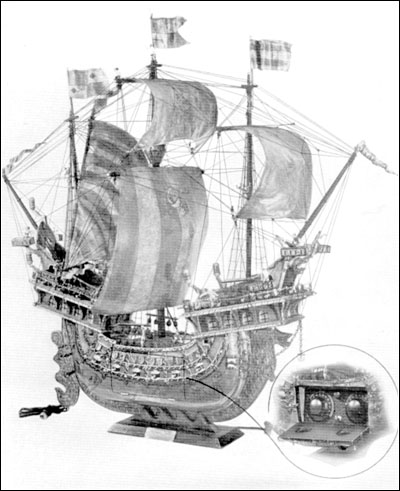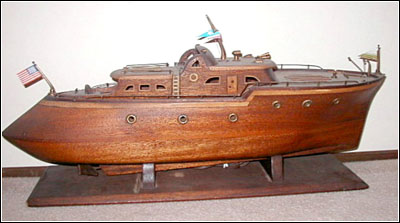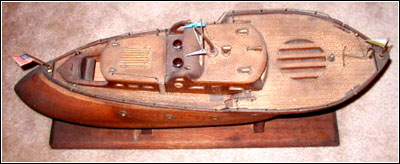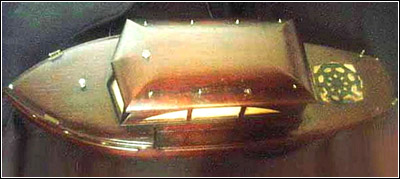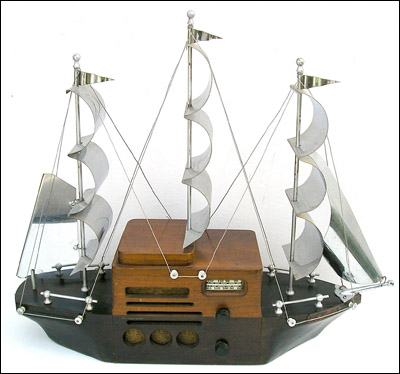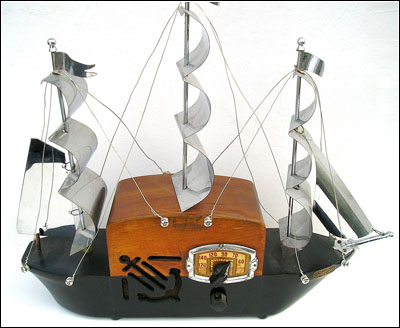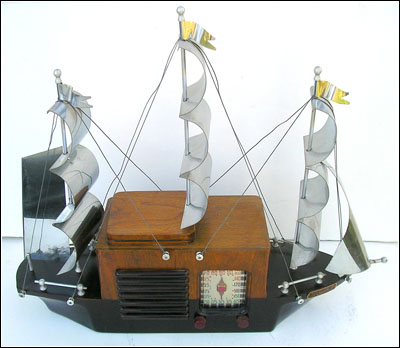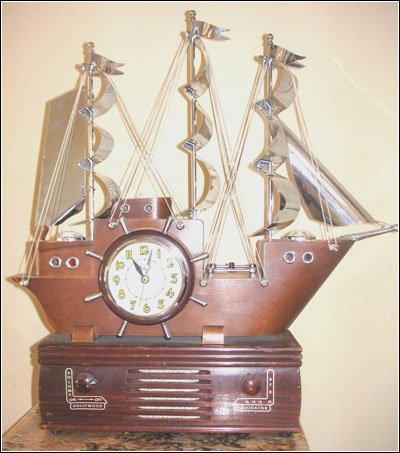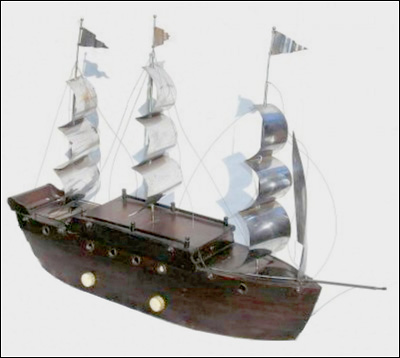Of Old Radios And Related Items--Published Monthly
Vacuum Tube Ship Radios
BY JACK GRAY
Web Edition
Tragedies at sea like the unforgettable "Titanic" would have multiplied beyond comprehension if radio and nautical technology had not grown together throughout the 20th century. One way that the commercial effect of that collaboration became evident was that radio manufacturers began to market ship designs for their novelty products. Jack Gray describes some of those products in the following article. (Editor)
Communication with ships at sea was one of the earliest practical uses of radio. It greatly reduced the isolation of ships, saving thousands of lives. In the first couple of decades of this application, radio was generally limited to Morse Code transmissions. However, the 1912 sinking of the Titanic clearly illustrated the value of radio to ocean-going vessels.
Figure 1. A very large "Venetian Merchantman," ca 1926-1927, a top-of-the-line model listed for $500.By 1914 the use of radio by seagoing vessels was well established, and the marriage of radio and ships has continued to grow to the present day. Radio technology provides not only communication but also safety enhancement through the use of radar and loran, and, more recently, precise navigation by universal use of global positioning systems.
Just as the ship operators have adapted to the many uses of radio technology, the radio equipment manufacturers have adapted ship designs to their products. Collector's guides to novelty radios show many transistor novelty sets that were made to replicate early ship designs, as well as other nautical equipment, such as an engine order telegraph, an outboard motor, a life preserver, and a Morse code key.
Similarly, a number of early radio speakers with ship designs have been identified in other publications, including the July 1997, January 1999, and October 1999 issues of A.R.C. An early radio antenna wooden ship design was also described in an article by Dave Gonshor in the February 2000 issue of A.R.C. This article focuses specifically on early vacuum tube novelty radios that were made as or incorporated into models of ships. The following is my list of identified vacuum tube ship model radios.
Figure 2. A side view of a large cabin cruiser, ca 1941, with an internal radio and a circular cutout design on the foredeck.
Figure 3. A top view of the same large cruiser showing its cabin under which the radio is housed with controls extending into the bridge area.The "Venetian Merchantman"
The earliest vacuum tube radio in the design of a ship that I have identified is a battery-powered set called the "Venetian Merchantman," shown in Figure 1. It was made in 1926-1927 by Miniature Ship Models of Philadelphia. This model, along with some others which incorporated radio speakers, is described in a company brochure, "Ship Models -- Their History and Radio Loudspeakers." Some of the speaker designs were also documented by Dave Crocker in the October 1999 issue of A.R.C.
The "Venetian Merchantman" was at the top of the company line. It was very large -- 53" high, 22" wide, and 43" long. A 5-tube, TRF, battery set, it was housed behind a hinged panel in the hull. It featured a Melody speaker sail (see box on page 11 for a description), electric lights, and a full, cast iron crew of 16 sailor figures. It was not sold in kit form and was listed complete at a price of $500. I do not know of a surviving example, but perhaps someone out there does.
Figure 6. A "Radio Launch," model and maker unknown, with lights and radio mounted in the hull under the hinged cabin.Two Cabin Cruisers, Maker and Model Unknown
Shown in Figures 2 and 3 is a large cabin cruiser, ca 1941, maker and model unknown, which may be unique. The cruiser is approximately 261/2" long, 71/2" wide and 10" high with an internal radio and circular grille cutout design on the foredeck.
A 4-tube AC/DC model, the radio is housed under the cabin with controls extending into the bridge area. It has a tube layout and circuit similar to a DeWald Model 406R. I suspect that this set and the one that follows may be ship models that were adapted at some stage to house a radio within the hull. The set is from my collection.
Figures 4 and 5 (see print version) show another possibly unique, large cabin cruiser, ca 1941. It is from the collection of Chris Probert. The hull is approximately 24" long, 7" wide, and 10" high with internal radio. The speaker is mounted in the open-front cockpit. It is a 5-tube radio having a chassis layout and IF transformer part numbers and knobs that are like an Airline Model 14BR-521A. The model and maker are unknown.
The "Radio Launch," Maker and Model Unknown
The "Radio Launch," shown in Figures 6, (7, and 8 see print version) may be another unique set, model and maker unknown. The hull is approximately 20" x 6" x 6". It is a dark wood launch design with lights and radio mounted in the hull under the hinged cabin. It sold on eBay in 2004, and the current owner is unknown.
The Majestic "Melody Cruiser"
Figure 9. The Majestic "Melody Cruiser," ca 1941, uses the same chassis and dial as the Majestic "Charlie McCarthy" radios.Shown in Figure 9 is a Majestic set from my collection, possibly a Model 1S49. It has three masts with chrome sails, and the bow plate reads, "Majestic Melody Cruiser." This model, ca 1941, uses the same chassis and dial as the Majestic "Charlie McCarthy" radios.
Arvin Radio Cruiser
The model number of the set in Figures 10 and 11 (see print version), also from my collection, is unknown. It uses an Arvin Model 444 chassis and has three masts with chrome sails and a chrome dial escutcheon. The bow plate label reads, "Radio Cruiser," and the grille is a cutout anchor design. Although manufactured by Arvin, this model was marketed by Imperial, as shown on page 69 of Evolution of the Radio, Vol. I.
General Radio and Television Model 920.
The General Radio and Television Model 920, shown in Figure 12, has three masts with chrome sails. Its bow plate reads "Melody Radio Cruiser," and an aluminum foil across the back of the chassis names the Chicago company and the model number 920. Like some other General Radio and TV Company sets, ca 1948, this model has a vertically oriented dial and a plastic grille with seven bars. The set is from my collection.
Figure 10. An Arvin "Radio Cruiser," model number unknown.Mastercrafters
Model 921The Mastercrafters Model 921, for which no illustration was available, has three masts with chrome sails. The bow plate reads "Melody Radio Cruiser." This model is quite similar to the Model 920, but the dial is oriented horizontally and the grille bars are made of wood. I believe this set was also made by General Radio and Television, but marketed by others.
The schematic and chassis information on the internal label also identifies it as a "Mastercrafters Model 921." However, it is pictured and identified as a "Majestic Melody Cruiser" in Evolution of the Radio, Vol. 2, and in Radios The Golden Age.
Figure 12. The General Radio and Television Model 920, ca 1948, has a vertically oriented dial and a 7-bar plastic grille.The "Hollywood Navigator"
The "Hollywood Navigator" shown in Figure 13 is from the collection of Chris Probert. It has three masts with chrome sails on a ship with a clock. The ship sits on top of the radio contained in the base cabinet. Labeled "Hollywood" and "Navigator" under the volume and tuning controls, it is approximately 19" long, 19" high and 41/2" wide. The base cabinet is 121/4" long and 41/2" high, and the clock is labeled "United." Another picture of this set may be seen on page 236 of Machine Age to Jet Age, Vol. I.
British Ship Radio, Maker and Model Unknown
The "British Ship Radio," maker and model unknown, shown in Figure 14, has three masts with chrome sails and six portholes along the upper section of the hull. It is approximately 20" long, 4" wide and 5" high (not including sails). The raised cabin in the center section is approximately 2" high and 10" long. It was sold from England on eBay in 2004, and the current owner is unknown.
Figure 13. Both radio and clock are obvious components of the "Hollywood Navigator."Modern Novelty Co. "Old Mariner"
The "Old Mariner" sailboat radio by the Modern Novelty Co., ca 1941, shown in Figures 15, 16, and 17, (see print version) is from the collection of Chris Probert. The label "Old Mariner Modern Novelty Co." and the patent number 123493 are shown on the bottom label. The patent shows this set as a single-masted sailing ship with metal sails and a clock, but also describes it as a design that might be used for other purposes. This example with a vacuum tube radio is shown in "as found" condition without sails. It is approximately 211/2" long, 5" wide, and 24" high.
The reader should understand that the information on the models that I have described is based on my review of available literature, as well as on my own radio collecting experience. I have also included information from my contacts with other early novelty radio collectors. Additional detailed information about the radios described or other designs not mentioned here would be sincerely appreciated.
Figure 14. A "British Ship Radio," model and maker unknown, with three masts, chrome sails, and six portholes along the hull.References:
Collins, Philip. Radios the Golden Age. San Francisco: Chronicle Books, 1987, p. 73.
Crocker, Dave. "Three Ship Speakers." Carlisle, Mass.: Antique Radio Classified, Oct. 1999.
Desjarlais, Dick, Richard Groman, Dave Crocker. "More on Cone Ship Speakers." Carlisle, Mass.: Antique Radio Classified, Jan. 1999.
_______, Alan Douglas, Dave Crocker. "Cone Ship Speakers." Carlisle, Mass.: Antique Radio Classified, July 1997.
Gonshor, Dave. "A Ship Antenna." Carlisle, Mass.: Antique Radio Classified, Feb., 2000.
"Ship Models -- Their History and Radio Loudspeakers." Philadelphia, Penn.: Miniature Ship Models, Inc., 1927.
Stein, Mark V. Machine Age to Jet Age, Vol. I. Baltimore: Radiomania Publishing, 1948, p. 236.
Wood, Scott. Evolution of the Radio, Vol. I. Gas City, Ind.: L-W Books, 1991, p. 69.
_______. Evolution of the Radio, Vol. 2. Gas City, IN.:L-W Books, 1993, p. 128.
Jack Gray received a BSEE in electrical engineering from the University of California at Berkeley and served in the U.S. Navy as an Aviation Electronics Technician. He has been actively collecting and restoring radios as a hobby for over 30 years.
|
[Free Sample] [Books, etc., For Sale] [Subscribe to A.R.C./Renew] [Classified Ads] [Auction Prices] [Event Calendar] [Links] [Home] [Issue Archives] [Book Reviews] [Subscription Information] [A.R.C. FAQ]URL = http://www.antiqueradio.com/Oct08_Gray_ShipRadios.html Copyright © 1996-2008 by John V. Terrey - For personal use only. Last revised: September 30, 2008. For Customer Assistance please contact ARC@antiqueradio.com or call (866) 371-0512 toll free Pages designed/maintained by Wayward Fluffy Publications Antique Radio Classified |
